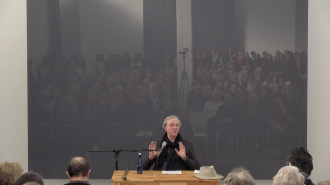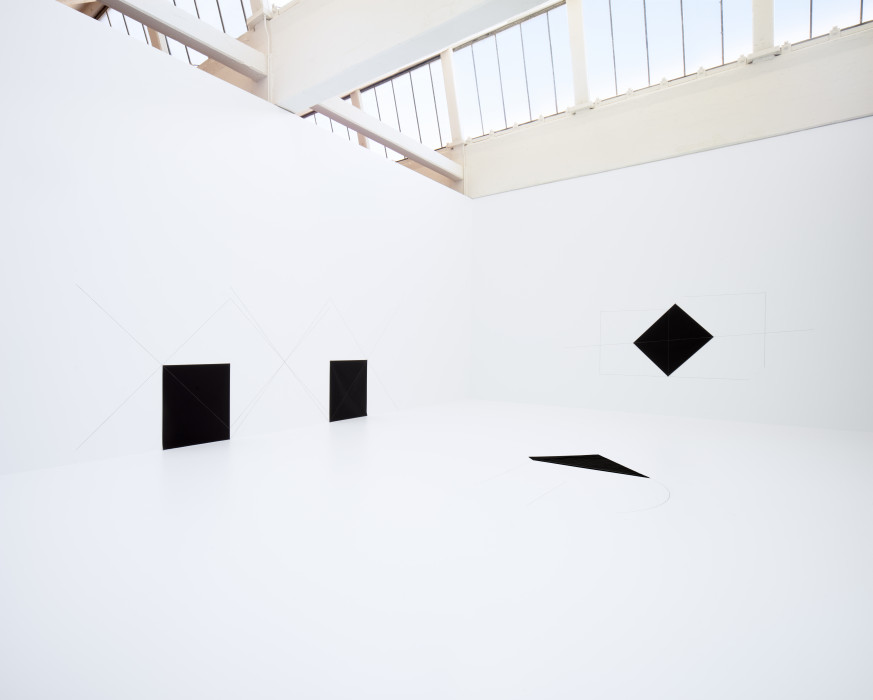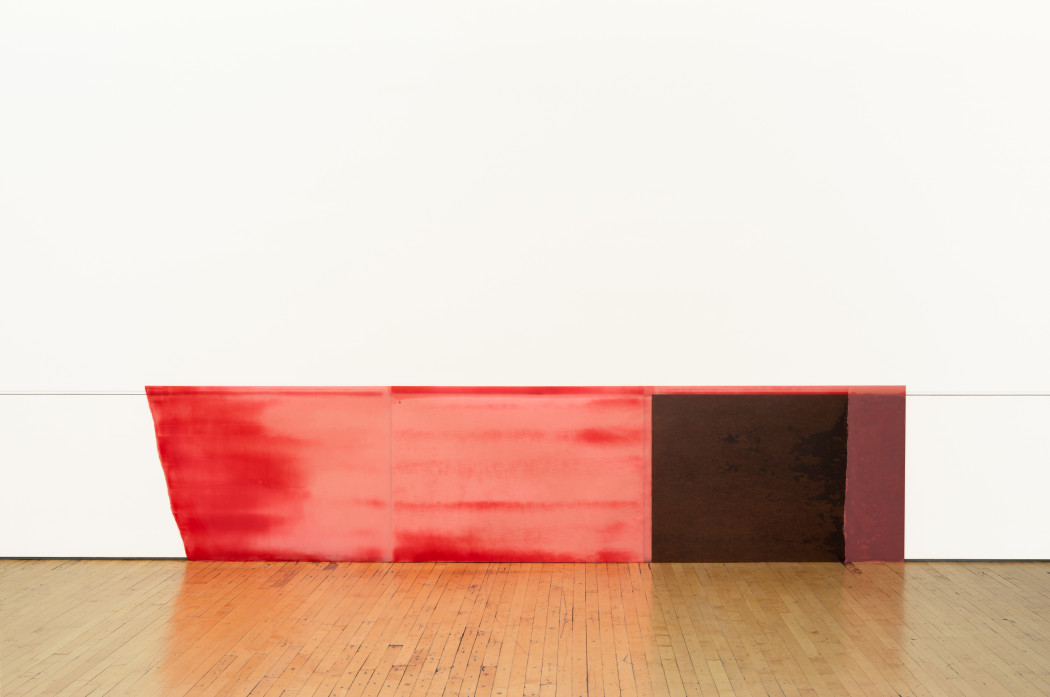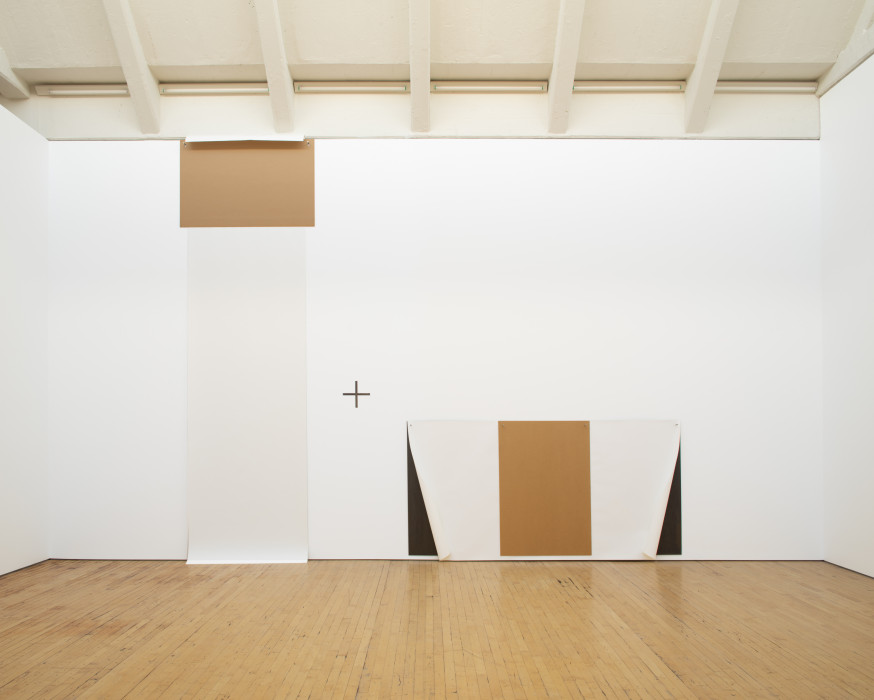Dorothea Rockburne
May 6, 2018—November 27, 2022, Dia Beacon
Overview
Following the 2018 presentation of Dorothea Rockburne’s large-scale works from the late 1960s and early 1970s, Dia has reopened the expanded exhibition with two new galleries, focusing on works produced in the early 1970s through the early 1980s. The first gallery features a carbon paper installation, a material the artist began using in the early 1970s: she would fold, press, and score sheets against the wall, allowing marks to durationally “make themselves” as pigment was disturbed and transferred to other surfaces. The second gallery presents works from Rockburne’s Golden Section painting series of the 1970s, constructed from linen coated in gesso and varnish, which she then cut and folded according to the mathematical ratio. The artist became preoccupied with the Golden Section as she pursued a new artistic language inspired by the presence of geometry in both nature and industrial surroundings. Also on view are five of her Egyptian Paintings, a monochromatic series developed in the late 1970s, which employed new materials and incorporated her interest in the art of ancient Egypt.
Dorothea Rockburne is made possible by significant support from COS and Someland Foundation. Additional support is provided by the Beth Rudin DeWoody, May and Samuel Rudin Family Foundation; Kathy Fuld; Horace W. Goldsmith Foundation; New York State Council on the Arts, a State agency; and Samuel I. Newhouse Foundation, Inc.
Every surface in Dorothea Rockburne’s work has a distinct presence, whether it is the luster of densely applied graphite, the varnished folds of linen, the paint baked on with heat lamps, or the corporeal sheen of grease. Her practice incorporates an analysis of form and a bodily relationship to the work, where the inherent dynamics of specific materials form the locus of the art. Rockburne’s attention to materiality and intersection speaks to a varied background, spanning academic training at Montreal’s École des Beaux-Arts, interdisciplinary experimentation at Black Mountain College in North Carolina, and radical approaches to performance at New York City’s Judson Dance Theater. Rockburne’s mathematical studies with Max Dehn at Black Mountain, for example, deeply influenced her practice. Like logic or geometry, her oeuvre aims to describe the most far-reaching forces of the world in elegant yet deceptively simple terms.
By the 1960s, Rockburne had grown dissatisfied with her painterly work. She began to integrate thought and emotion with freely available industrial materials “to form a new and forceful motivating engine,” and further educated herself about geometry, topology, and set theory—a mathematic concept wherein a collection of elements is conceived as a whole. In Tropical Tan (1967–68), four adjoined pig-iron panels are painted across the center, leaving a steel border exposed. The crimped panels magnify the interplay of these materials, particularly when light hits the surface. The cross formed within the bend of each panel is a unifying structural motif—prefiguring the artist’s ongoing fascination with the potential of the fold—inspired by the air ducts seen from her studio window.
Even when she returned to materials linked to drawing and painting, Rockburne eschewed normative approaches, choosing instead to innovate form using the fluid logic of relief. In Set (1970/2018), she hangs, manipulates, overlaps, and spaces paper and chipboard into units suspended from the wall. For Intersection (1971/2018), the artist placed sheets of partially rolled plastic and paper perpendicular to the wall beneath a line marked in charcoal. Unfurled on the floor, paper is soaked in oil until translucent and then affixed to another sheet of plastic. While the oil (originally crude oil) evokes the industrial materials used by peers such as Carl Andre and Donald Judd, Rockburne offers a unique combination of sculptural procedure and visceral matter, marked by the influence of set theory.
Although Domain of the Variable (1972/2018) asserts a relation to conceptual math in both title and organization, it also forces a physical reading of the work. Paper board glued to the wall is stripped, leaving a painterly trace. Red grease is smeared on paper and board to stain the gallery wall. For the Golden Section Paintings (1974—76) Rockburne follows their titular geometric proportions, yet articulates them by stapling linen to the wall, lining surfaces in varnish and gesso, and then measuring, cutting, and folding various planes. Folding, a key process in the Egyptian Paintings (1979–81) and Locus (1972), addresses how forms can modify their shape while holding their physical integrity when their material is altered.
The Carbon Paper Installation elucidates the social, even participatory, aspects of Rockburne’s process. Based on a 1973 presentation at the Bykert Gallery in New York, the work offers a model for collective mark making. Residue accrues not only from the artist’s manipulation, but also from the materials’ impressions on one another, and viewers’ contact with the installation. For this iteration, Rockburne painted the walls and floors of the gallery in a brilliant white not intended to remain immaculate: fingerprints linger from the installation of the paper works, while the footprints of museum visitors will accumulate over time.
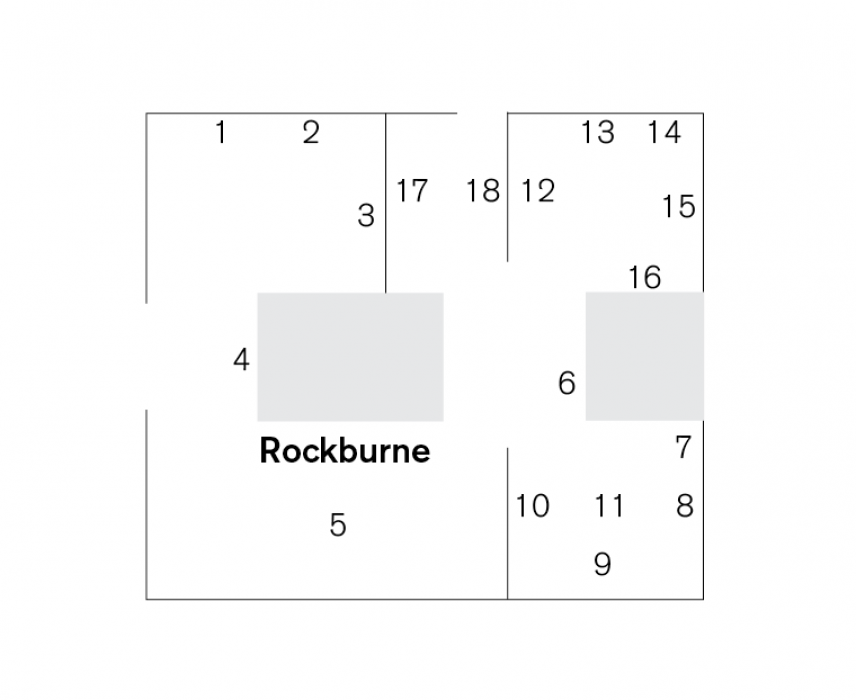
1. Golden Section Painting: Two Triangles and Rectangle, 1974
Linen, gesso, glue, chalk, and varnish
Courtesy the artist
2. Golden Section Painting: Triangle, Small Square, 1974
Linen, gesso, glue, chalk, and varnish
Courtesy the artist
3. Set, 1970/2018
Paper, chipboard, graphite, and nails
Edition 2/3
Dia Art Foundation
4. Intersection, 1971/2018
No. 4 heating oil, plastic, paper,
chipboard, and charcoal
Edition 2/3
Dia Art Foundation
5. Domain of the Variable, 1972/2018
Chipboard, contact cement, paper, grease, and charcoal
Edition 2/3
Dia Art Foundation
6. Carbon Paper Installation: Gate, 1973/2018
Carbon paper, pencil, and Conté crayon
Courtesy the artist
7. Carbon Paper Installation: Diamond Parallelogram, 1973/2018
Carbon paper, pencil, and Conté crayon
Courtesy the artist
8. Carbon Paper Installation: M. G.’s Piece, 1973/2018
Carbon paper, pencil, and Conté crayon
Courtesy the artist
9. Carbon Paper Installation: Hartford, 1973/2018
Carbon paper, pencil, and Conté crayon
Courtesy the artist
10. Carbon Paper Installation: Whitney
Piece, 1973/2018
Carbon paper, pencil, and Conté crayon
Courtesy the artist
11. Carbon Paper Installation: Arc, 1973/2018
Carbon paper, pencil, and Conté crayon
Courtesy the artist
12. Egyptian Painting: Sepa, 1980
Conté crayon, pencil, oil, and gesso on linen
Courtesy the artist
13. Egyptian Painting: Stele, 1980
Gesso, Conté crayon, oil, and contact cement on linen
Courtesy the artist
14. Egyptian Painting: Scribe, 1979
Conté crayon, pencil, oil, and gesso on linen
Courtesy the artist
15. Egyptian Painting: Basalt, 1981
Oil, glue, pencil, and gesso on linen
Courtesy the artist
16. Golden Section Painting: Square Separated by Parallelogram with Diamond, 1974–76
Gesso, glue, and blue pencil on folded linen
Courtesy the artist
17. Tropical Tan, 1967–68
Wrinkle-finish paint on steel
Courtesy the artist
18. Locus, 1972
Etching, aquatints, pencil, and oil on
folded paper
Edition 5/42
Dia Art Foundation; Gift of the Dorothea Rockburne Foundation
Dorothea Rockburne was born in 1932 in Montreal, where she studied art and philosophy before attending Black Mountain College near Asheville, North Carolina, from 1950 to 1954. While at Black Mountain, Rockburne met the mathematician Max Dehn, whose tutelage in concepts including harmonic intervals, topology, and set theory were deeply influential to her art practice. After moving to New York City in 1954, she became involved with the nascent Judson Dance Theater, and later participated in Carolee Schneemann’s Meat Joy (1964), among other notable performances. In the late 1960s Rockburne began exhibiting paintings made with industrial materials and creating drawings from crude oil and graphite applied to paper and chipboard. Her works based on set theory, what the artist refers to as “visual equations,” were first exhibited in New York in 1970. Later phases of Rockburne’s painting practice draw on ancient systems of proportion as well as astronomical phenomena. Her work has been featured in two solo exhibitions at the Museum of Modern Art in New York (1981 and 2013–14) and a major retrospective at the Parrish Art Museum in Southampton, New York (2011), which traveled to the Museum of Fine Arts in Montreal. Rockburne resides in New York.
Artist
Dorothea Rockburne
Dorothea Rockburne was born in Montréal in 1932. She lives and works in New York City.
Explore
Robert Storr on Dorothea Rockburne
Move to Robert Storr on Dorothea Rockburne page